Cullan Hudson's Blog, page 7
September 26, 2016
Horrifying Vintage Costumes...by Kids
Remember when kids made their own costumes forHallowe'en? It was a simpler, safer, and moreinnocent time...or so you'd think. Check out thesevintage creepy AF costumes. All I can say is fewthings are as creepy as a pillowcase mask with jaggedholes ripped into it or a crudely hewn papier mache mask.

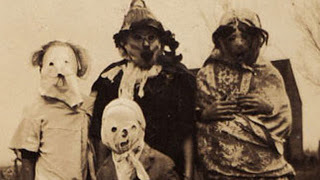
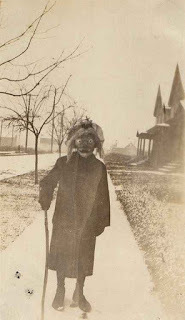





Published on September 26, 2016 06:18
Strange Signals in September
 As the story goes, in September 1953 in the town of Morecambe in Lancashire, England a specialist in the nascent technologies of broadcast television picked up an unusually long-distance transmission from Houston, TX. So, too, did others throughout England as they sat about their sets. The station identification placard for KLEE-TV was only up for a moment, but it struck them odd that such a signal could reach them from half a world away. Stranger still, when investigated, it came to be learned that this station had gone off the air three years prior. Where did the signal come from? Where had it been?
As the story goes, in September 1953 in the town of Morecambe in Lancashire, England a specialist in the nascent technologies of broadcast television picked up an unusually long-distance transmission from Houston, TX. So, too, did others throughout England as they sat about their sets. The station identification placard for KLEE-TV was only up for a moment, but it struck them odd that such a signal could reach them from half a world away. Stranger still, when investigated, it came to be learned that this station had gone off the air three years prior. Where did the signal come from? Where had it been?Apparently, it hadn't. It seems the whole thing was a hoax.
KPRC-TV in Houston received a letter and a photograph one day from England that read:
"Enclosed herewith is a photograph taken by an ordinary box camera of what I believe is your test signal received 3:50 p.m. 14 September 1953. It would be of great interest and help if you could be so kind as to confirm or deny by return mail that this is so and at the same time it would be of great help if you would endorse the back of the photograph and return. Your help in this matter would be much appreciated."
This baffled the staff since it was not only technologically improbable that a signal from Texas would ever reach England (to say nothing of incompatible natures of American and British TV technologies), but KPRC-TV had bought out KLEE-TV back in 1950, changing the call letters at that time. No one had seen a KLEE-TV identification broadcast since.
Hypotheses were trotted out. These included the possibility that English viewers had actually seen an advertisement for Kleenex that had perhaps become distorted. The BBC could neither confirm nor deny that the errant broadcast had occurred. This would have been enough ambiguity to give birth to an urban legend, but experts at the Chrysler Corporation determined the image was authentic and that was all the burning bush anyone needed to pass the tale on as gospel.
But there are problems with the tale. KPRC-TV, for one, received only one copy of what appeared to be a form letter. Similar letters were sent out to stations all over that included these photographs of various station identification cards showing their call letters
. These were sometimes close to but just different enough from the actual cards broadcast by the station that those in the know were suspicious from the start.
In corresponding back, KPRC-TV learned that a hoax was afoot to sell the English on a new type of television that could pull broadcasts from all over the world. To prove this, the hoaxers played various faked call signs from stations in the USA, South America, and even in Russia (all in English, of course) through their sets and encouraged viewers to take pictures as proof and verify themselves that these call letters were real. And this, so the explanation states, is where the letters came from.
But is this the truth? Letters were received, true, but the seemed to be strikingly similar, according to reports, thus bolstering the "form letter" hypothesis that these letters all came from the same source. Was there ever actually a scam to sell these exceptional TV sets that could retrieve signals from all over the globe? Or was that another lay of a more complicated hoax?
It's not hard to see why the legend endures, given that even the supposed known facts aren't much more solid than the hearsay of the original tale.
"Unexplained Mysteries of the 20th Century," Janet and Colin Bord
http://www.snopes.com/radiotv/tv/klee.asp
Published on September 26, 2016 05:37
February 29, 2016
Nemeta: Sacred Sites of the Ancient Celts
 "No bird nested in the Nemeton, nor did any animal lurk nearby; the leaves constantly shivered though no breeze stirred. Altars stood in its midst, and the images of the gods. Every tree was stained with sacrificial blood. the very earth groaned, dead yews revived; unconsumed trees were surrounded with flame, and huge serpents twined round the oaks. The people feared to approach the grove, and even the priests [druids] would not walk there at midday or midnight lest he should then meet its divine guardian." -- Lucan, Pharsalia
"No bird nested in the Nemeton, nor did any animal lurk nearby; the leaves constantly shivered though no breeze stirred. Altars stood in its midst, and the images of the gods. Every tree was stained with sacrificial blood. the very earth groaned, dead yews revived; unconsumed trees were surrounded with flame, and huge serpents twined round the oaks. The people feared to approach the grove, and even the priests [druids] would not walk there at midday or midnight lest he should then meet its divine guardian." -- Lucan, PharsaliaTo the Celtic peoples, Nemeta were sacred places, often a copse or rock outcropping, utilized for ritual purposes. The goddess Nemetona was the divine guardian that Lucan spoke of. Given that even Romans such as Marcus Aurelius allied her with the war god Mars, it can be concluded that she was seen as fearful indeed.
These Nemeta can be found in Spain, Portugal, France, Germany, and in the UK and Ireland.
The Nemeton derives its name from the Latin nemus (plural: nemora), meaning forest or woods. The related word, Lucus, refers specifically to a sacred grove.
Published on February 29, 2016 06:55
February 28, 2016
The Lunacy of Lost 'London'
 The famous lost Lon Chaney film, "London After Midnight" (aka "The Hypnotist") was said to be the driving force behind the murder of Julia Mangan in London's Hyde Park in October of 1928.
The famous lost Lon Chaney film, "London After Midnight" (aka "The Hypnotist") was said to be the driving force behind the murder of Julia Mangan in London's Hyde Park in October of 1928. The killer, a Welsh carpenter named Robert Williams, believed that Chaney's unnerving depiction of a near-supernatural killer in the film had driven him insane. It was reported that Williams could see Chaney in a corner, shouting and making faces at him and that he felt as if steam were coming out of his own ears.
Williams seemed to think he had been set into a dissociative
state by this apparition because he could not remember pulling a razor from his pocket and slitting Mangan's throat or attempting then to take his own life.
The defense attempted to pin his unhinging on the disturbing visage Chaney donned for his character in London After Midnight, but the jury didn't buy it: They sentenced Williams to death on January 10, 1929.
Published on February 28, 2016 10:42
February 14, 2016
The Blue Man
 Someone I know recently shared a strange encounter he had at a Walmart in Texas (I know, I know...narrow it down, right?) that left him a bit bewildered and somewhat unsettled.
Someone I know recently shared a strange encounter he had at a Walmart in Texas (I know, I know...narrow it down, right?) that left him a bit bewildered and somewhat unsettled. An elderly man in sunglasses spotted him from across the crowded store, and seeing him leaving, somehow managed to beat him outside where he cornered my friend and began speaking to him as if the two had been long time pals. The elderly man proceeded to harangue him on myriad topics, including politics. However, the man seemed to have no specific information upon which to talk, forming instead a Dadaist rant that left my friend unnerved. To be fair, much of his discomfort stemmed from the fact the old stranger was... Well, he was blue. His skin was blue.
After several minutes of this rambling conversation, my friend managed to extricate himself from the situation and the elderly blue gentleman drove off in his Cadillac.
So my friend asks me if I had ever heard of people with blue skin. As it turns out, I have.
Methemoglobinemia is a rare condition (often genetic) that occurs when there is too much methemoglobin in the blood, a situation that can leave the skin with a bluish cast. On a fairly pale skinned individual, this would likely present as a striking blue shade.
A 19th Century Kentucky family, known as the "Blue Fugates" were a famous example of this oft-heriditary condition. And in 1942, the "Blue Men of Lurgan" were treated by Irish doctor, James Deeny.
Still, this doesn't explain the other weird aspects of my friends own blue man encounter that left him disturbed.
Published on February 14, 2016 16:45
December 5, 2015
Crete's Petrified Monsters

Agii Theodori, the petrified monsters, are two small islands off the coast of Crete. Legend tells that long ago these islands didn't exist. A sea monster and its baby were coming to attack the villagers who prayed to the Virgin Mary and to St. George to spare them. Then a miracle occurred and the monsters were petrified into stone, thus forming these two small islands.
Published on December 05, 2015 10:56
November 2, 2015
Detroit Ghost City
Check out this haunting documentary about the spirits that haunt Detroit, MI, a city that is fast becoming America's haunted house.
Published on November 02, 2015 05:46
October 25, 2015
Strange Travels: Greece, Turkey, Croatia (Part I)
I recently returned from visiting Turkey, Greece, and Croatia. As always, I collected stories along the way as I visited ancient Greek and Roman ruins, Byzantine palaces, historic mosques, and more. Some of the strangest are as follows.
 Daksa Island, in the Adriadic, lies within swimming distance of the Croatian city of Dubrovnik. The island's haunted reputation arises from a legend about 48 presumed Nazi collaborators that were executed without trial on the uninhabited island at the close of World War II.
Daksa Island, in the Adriadic, lies within swimming distance of the Croatian city of Dubrovnik. The island's haunted reputation arises from a legend about 48 presumed Nazi collaborators that were executed without trial on the uninhabited island at the close of World War II.  Also close to shore is the neighboring island of Lokrum, which has its own dark legends. The curse, they call it, befell the island when occupying French forces ordered a 13th century monastery on the island to be shuttered. The Benedictines who were removed leveled a curse against anyone claiming ownership of the small island. It seemed to work almost immediately, three of the aristocrats who colluded with the Benedictine expulsion met with untimely deaths shortly thereafter. A wealthy seaman, Captain Tomaševic, took over the island next and it nearly bankrupted him. The Archduke Maximilian, the younger brother of the Austrian Emperor Francis Joseph I, took up residency next, restoring the monastery as a home for he and his wife. The idyllic sanctuary was shattered when Maximilian was sent to Mexico in 1864 as governor. He was shot to death less than 3 years later. After the city of Dubrovnik refused to purchase the island--even for an extremely paltry sum--a man named Dujmovic from Poljica purchased Lokrum and scandalously met economic ruin soon after. His nephew soon inherited the island, but he drowned crossing the short distance from the shore to the island when his boat capsized in a strong wind. Once more the Hapsburg's took control off the island. Rudolf, the remaining son of Emperor Francis Joseph I and his bride Elizabeth, visited the tiny island with the big curse with his wife Stefani. Legend tells that a small earthquake shook the region the moment they stepped ashore. While initially a blissful tenure, things grew darker when Rudolf fell in love with his mistress Maria Vecer and, for reasons unexplained, they took their lives in a double suicide. Empress Elizabeth decided they needed to be rid of the accursed island and so she sailed from her palace on Corfu to offer a large sum of money to the Benedictines if they took the island back. But the brotherhood stood firm on their decree to never return to the island. So, the family offered the island to the Dominicans with the provision that the Hapsburg family could repurchase the island if they so chose to. And they did. The granddaughter of Francis Joseph I, Princess Elizabeth Windischgratz, purchased Lokrum in 1879. But the title wasn't transferred immediately. When it was finally put down into the family name again, tragedy struck. Empress Elizabeth left her palace on Corfu to return to Geneva when she was shot and killed by an Italian anarchist named Lucceni. The mishaps for the Hapsburgs are legendary, including Archduke Francis Ferdinand whose assassination kicked off the first World War. But legend tells that the island's curse is still palpable and that many non-famous or historical persons have fallen to it. Few, they say, have stayed long of the cursed island of Lokrum.
Also close to shore is the neighboring island of Lokrum, which has its own dark legends. The curse, they call it, befell the island when occupying French forces ordered a 13th century monastery on the island to be shuttered. The Benedictines who were removed leveled a curse against anyone claiming ownership of the small island. It seemed to work almost immediately, three of the aristocrats who colluded with the Benedictine expulsion met with untimely deaths shortly thereafter. A wealthy seaman, Captain Tomaševic, took over the island next and it nearly bankrupted him. The Archduke Maximilian, the younger brother of the Austrian Emperor Francis Joseph I, took up residency next, restoring the monastery as a home for he and his wife. The idyllic sanctuary was shattered when Maximilian was sent to Mexico in 1864 as governor. He was shot to death less than 3 years later. After the city of Dubrovnik refused to purchase the island--even for an extremely paltry sum--a man named Dujmovic from Poljica purchased Lokrum and scandalously met economic ruin soon after. His nephew soon inherited the island, but he drowned crossing the short distance from the shore to the island when his boat capsized in a strong wind. Once more the Hapsburg's took control off the island. Rudolf, the remaining son of Emperor Francis Joseph I and his bride Elizabeth, visited the tiny island with the big curse with his wife Stefani. Legend tells that a small earthquake shook the region the moment they stepped ashore. While initially a blissful tenure, things grew darker when Rudolf fell in love with his mistress Maria Vecer and, for reasons unexplained, they took their lives in a double suicide. Empress Elizabeth decided they needed to be rid of the accursed island and so she sailed from her palace on Corfu to offer a large sum of money to the Benedictines if they took the island back. But the brotherhood stood firm on their decree to never return to the island. So, the family offered the island to the Dominicans with the provision that the Hapsburg family could repurchase the island if they so chose to. And they did. The granddaughter of Francis Joseph I, Princess Elizabeth Windischgratz, purchased Lokrum in 1879. But the title wasn't transferred immediately. When it was finally put down into the family name again, tragedy struck. Empress Elizabeth left her palace on Corfu to return to Geneva when she was shot and killed by an Italian anarchist named Lucceni. The mishaps for the Hapsburgs are legendary, including Archduke Francis Ferdinand whose assassination kicked off the first World War. But legend tells that the island's curse is still palpable and that many non-famous or historical persons have fallen to it. Few, they say, have stayed long of the cursed island of Lokrum. In the summer of 1969, a rain of frogs fell on the city of Istanbul. Famed anomalist Charles Fort collected many such accounts of "falls," as they're termed. Some may be explained by weather anomalies, but other far more unusual reportings are harder to rationalize.
In the summer of 1969, a rain of frogs fell on the city of Istanbul. Famed anomalist Charles Fort collected many such accounts of "falls," as they're termed. Some may be explained by weather anomalies, but other far more unusual reportings are harder to rationalize. 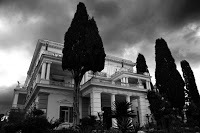 Some say the famous Empress Elizabeth of Bavaria still walks the halls of her Achillion Palace on the island of Corfu. On the Greek island of Crete, at a 14th century Venetian fortress known as Frangokastello, the Drosoulites come each year. These "Dew People," so named for their arrival with the morning dew, are shadow wraiths that ride horses and walk with weapons like a phantom army from the monastery at Agios Charalambos to Frangokastello. Legend has it that these are the Greeks who died in the battle of May 17, 1828. In 1890, Turkish soldiers fled in fear at the sight of the Drosoulites. In World War I, German soldiers opened fire when they mistook the spirits for enemy soldiers. Imagine their surprise at learning the truth.
Some say the famous Empress Elizabeth of Bavaria still walks the halls of her Achillion Palace on the island of Corfu. On the Greek island of Crete, at a 14th century Venetian fortress known as Frangokastello, the Drosoulites come each year. These "Dew People," so named for their arrival with the morning dew, are shadow wraiths that ride horses and walk with weapons like a phantom army from the monastery at Agios Charalambos to Frangokastello. Legend has it that these are the Greeks who died in the battle of May 17, 1828. In 1890, Turkish soldiers fled in fear at the sight of the Drosoulites. In World War I, German soldiers opened fire when they mistook the spirits for enemy soldiers. Imagine their surprise at learning the truth.
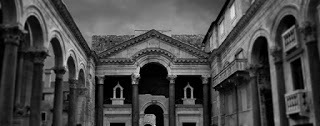
It's believed the ancient Roman spirits-lares and lemures-that once reigned over the palace of Diocletian in Split, Croatia still skulk about in the shadows.
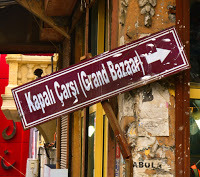 Some believe that Istanbul's Grand Bazaar--one of the largest and oldest shopping centers--is not only haunted but built around a portal leading to another dimension, doubtlessly some evil one.
Some believe that Istanbul's Grand Bazaar--one of the largest and oldest shopping centers--is not only haunted but built around a portal leading to another dimension, doubtlessly some evil one.
Published on October 25, 2015 09:09
October 21, 2015
London's Crime Museum Opens To The Public
Long shuttered away, the Museum of London's Crime Museum was once set up to train police and forensic officers. Now anyone can get a glimpse of these famous mementos of notorious crimes: masks used by the Stratton brothers, Champagne belonging to the Great Train Robbers, implements of forgery, secret Soviet spy messages, handwritten notes written by Donald Swanson, Senior Investigating Officer on the Jack the Ripper case... The list goes on.
Find out more at the Museum of London's website.
Published on October 21, 2015 07:34
August 24, 2015
A Gathering Of Ghosts
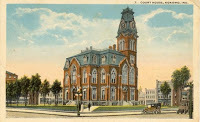 The story centers around this 1868
The story centers around this 1868courthouse, which was demolished
in 1927 and replaced by the County's
newer Art Deco structure.A story that ran in the mid-January papers of 1896 tells the weird tale of phantom footprints at a courthouse in Kokomo, IN. It seems officers who entered the well-secured building discovered the distinct footprints of a woman that traveled down the halls, up the stairs, and into locked rooms. The earliest reports of this manifestation began not long after the acquittal of a man for the murder of a young woman named Stansifer. Many came to believe these ghostly footsteps were her own as she trudged nightly on a sorrowful sojourn.
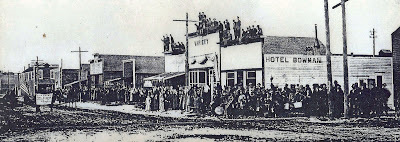 Nezperce in 1911 In the winter of 1906, a ghostly apparition stalked the dark streets of Nezperce, Idaho. C. W. Felt was the first to spot her. He was mocked for reporting a spectral woman in black whose face was obscured by a scarf walking silently through the dark streets, sometimes standing stark still for long stretches. But the laughter died off as others began to spot her as well. Young Mike O'Conner spotted her in an alley between two downtown buildings; John Olson was disturbed to find her standing in front of her home for more than two hours. Many of the sightings, some noted, occurred within the vicinity of John Muir's home. Muir had hanged himself on January 1, 1905--a year prior to the phantom woman's arrival.
Nezperce in 1911 In the winter of 1906, a ghostly apparition stalked the dark streets of Nezperce, Idaho. C. W. Felt was the first to spot her. He was mocked for reporting a spectral woman in black whose face was obscured by a scarf walking silently through the dark streets, sometimes standing stark still for long stretches. But the laughter died off as others began to spot her as well. Young Mike O'Conner spotted her in an alley between two downtown buildings; John Olson was disturbed to find her standing in front of her home for more than two hours. Many of the sightings, some noted, occurred within the vicinity of John Muir's home. Muir had hanged himself on January 1, 1905--a year prior to the phantom woman's arrival. Farmhand, Henry Lipenstick, disappeared in 1915 from a farm in Painesville, OH. Over the years following, that farm saw bad times: repeated crop failures, a house fire, and an inability to maintain any tenants. Locals blamed it on the ghost. It's probably the ghost that Carl Logies encountered when he purchased the land in 1921. Whenever Carl went to the barn, he would spot a white wraith. Disturbed, but not entirely put out, Carl followed the wraith with his gun on numerous occasions. The apparition always vanished in the vicinity of an old well. Finally, Carl decided to clean out the rock and debris that had been tossed down into the well. That's when he discovered the body of Henry Lipenstick. Once the Sheriff was called, it wasn't long before the dots were connected and a tenant from 7 years before, Frank Lemon, was in jail awaiting grand jury charges of murder.
Published on August 24, 2015 06:37



